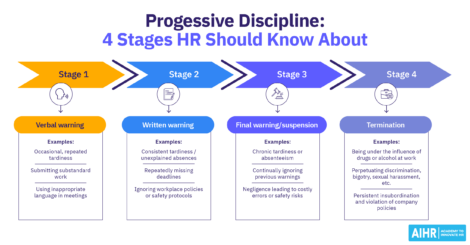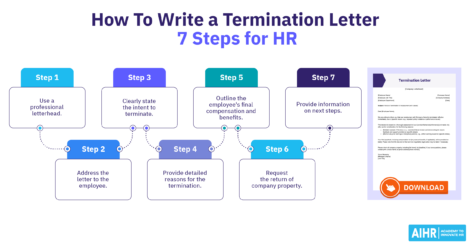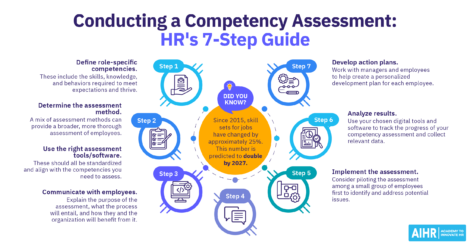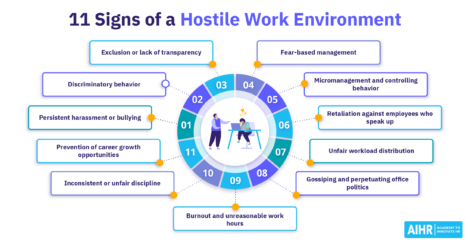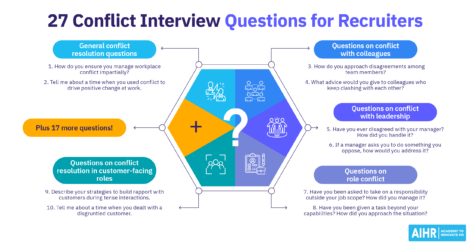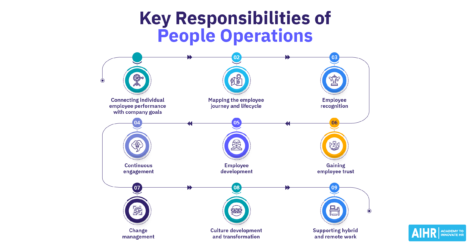23 Examples of Hostile Work Environment: How To Spot the Signs
22% of workers have witnessed discrimination in their workplace, with 15% having reported experiencing it themselves. Bullying, harassment, and retaliation aren’t just office drama — they can destroy employees’ mental health and the organization.

Examples of hostile work environments are more common than we’d like to think. 52% of employees have experienced or witnessed inappropriate, unethical, or illegal workplace behaviors, the most prevalent being bullying (51%), sexual harassment (40%), and racism (30%).
As an HR professional, you should be able to recognize a hostile work environment so you can help affected employees and help your company build a respectful, inclusive workplace. This article discusses what makes a hostile work environment, how to spot the signs, and offers relevant examples to increase your awareness of such issues.
Contents
What is a hostile work environment?
The differences between a hostile and toxic work environment
The impact of a hostile work environment
11 signs of a hostile work environment and how to handle them
23 examples of hostile work environments
What is a hostile work environment?
The legal definition of a hostile work environment is one where an employee directs unwelcome conduct at a colleague based on race, gender, age, religion, disability, or sexual orientation. This behavior is so severe or pervasive it prevents people from working harmoniously and disrupts business.
Such behavior — whether through bullying, persistent harassment, micromanagement, or gossip — disrupts productivity and violates laws like Title VII (U.S.), the Equality Act (UK), the Human Rights Act (Canada), and the Fair Work Act (Australia). HR and management must address these issues promptly to avoid legal and reputational damage.
The differences between a hostile and toxic work environment
Definition
A workplace where harassment or discrimination creates an intimidating or abusive environment that often violates legal standards.
A workplace with negative behaviors, poor management, or an unhealthy culture that harms morale but may not violate laws.
Key characteristics
Harassment, discrimination, bullying, threats, or retaliation targeting protected groups.
Poor leadership, gossip, favoritism, lack of support, high stress, and low morale.
Legal implications
Often legally actionable.
Generally not legally actionable.
Focus on negative behavior
Enforce anti-harassment policies, train staff set clear reporting channels, and take prompt corrective actions.
Does not target individuals based on protected characteristics; poor management or culture can affect anyone.
Impact on employees
Creates fear and distress, affecting employees’ performance and mental health.
Leads to burnout, lower morale and retention, and decreased productivity.
Responsibility to address
Targets individuals based on protected characteristics such as race, gender, age, sexual orientation, etc.
While not legally required, the employer should address these issues to maintain a healthy workplace and good reputation.
Examples
Racial slurs, sexual harassment, offensive jokes or remarks about protected traits.
Persistent negativity, unreasonable workloads, lack of recognition, poor communication.
Resolution approach
Do not target individuals based on protected characteristics; poor management or culture can affect anyone.
Promote open communication, supportive leadership, and proactive problem-solving.
The impact of a hostile work environment
A hostile environment leaves employees stressed, insecure, and burned out. It erodes self-confidence, damages mental health, and may even push some toward unhealthy coping methods.
For the organization, constant stress reduces productivity and creativity, increases absenteeism, and leads to higher turnover. This, in turn, forces costly recruitment and training and can attract legal penalties — further tarnishing the company’s reputation and affecting its ability to attract top talent.
Learn to prevent and handle a hostile work environment professionally
Learn how to spot, prevent and handle a hostile work environment professionally.
In AIHR’s Talent Management and Succession Planning Certificate Program you’ll learn how to build a healthy organizational culture and foster an environment that delivers a positive talent experience, enabling you to help your company avoid a hostile workplace.
11 signs of a hostile work environment and how to handle them
What makes a hostile work environment? Below are 11 signs to watch out for, as well as tips on how to handle each one:
- Persistent harassment/bullying: Ongoing unwanted behavior that negatively affects an employee’s wellbeing, and continues despite objections or warnings. This can include insults, intimidation, repeated offensive jokes or remarks, or quid pro quo harassment.
→ Solution: Document incidents thoroughly, confront those responsible for the behavior, and enforce a zero-tolerance policy. Additionally, provide anti-harassment training and set up a reporting system (if the organization doesn’t have one yet).
- Discriminatory behavior: Unfair treatment based on protected characteristics like race, gender, age, or disability that leads to biased hiring, promotion, or workplace interactions.
→ Solution: Offer support to affected parties, enforce corrective measures, and set up anonymous reporting channels. Discuss allegations and legal consequences with offenders and implement corrective measures like diversity training or disciplinary action.
- Exclusion or lack of transparency: Withholding key information, setting unclear expectations, or spreading misinformation.
→ Solution: Initiate open discussions, stress the importance of clear communication (especially if the offending party is a manager), and hold regular meetings with anonymous feedback options.
- Fear-based management: Employees rarely voice their opinions because they fear public reprimands from superiors or other negative consequences on their careers.
→ Solution: Encourage anonymous reporting, ensure psychological safety, train leaders and managers on emotional intelligence, and maintain an open-door policy.
- Micromanagement and controlling behavior: Excessive managerial oversight that stifles employee autonomy and confidence.
→ Solution: Coach or mentor employees to boost their confidence and train managers in trust-based leadership. Advise them to set explicit work expectations and allow employees more flexibility and autonomy.
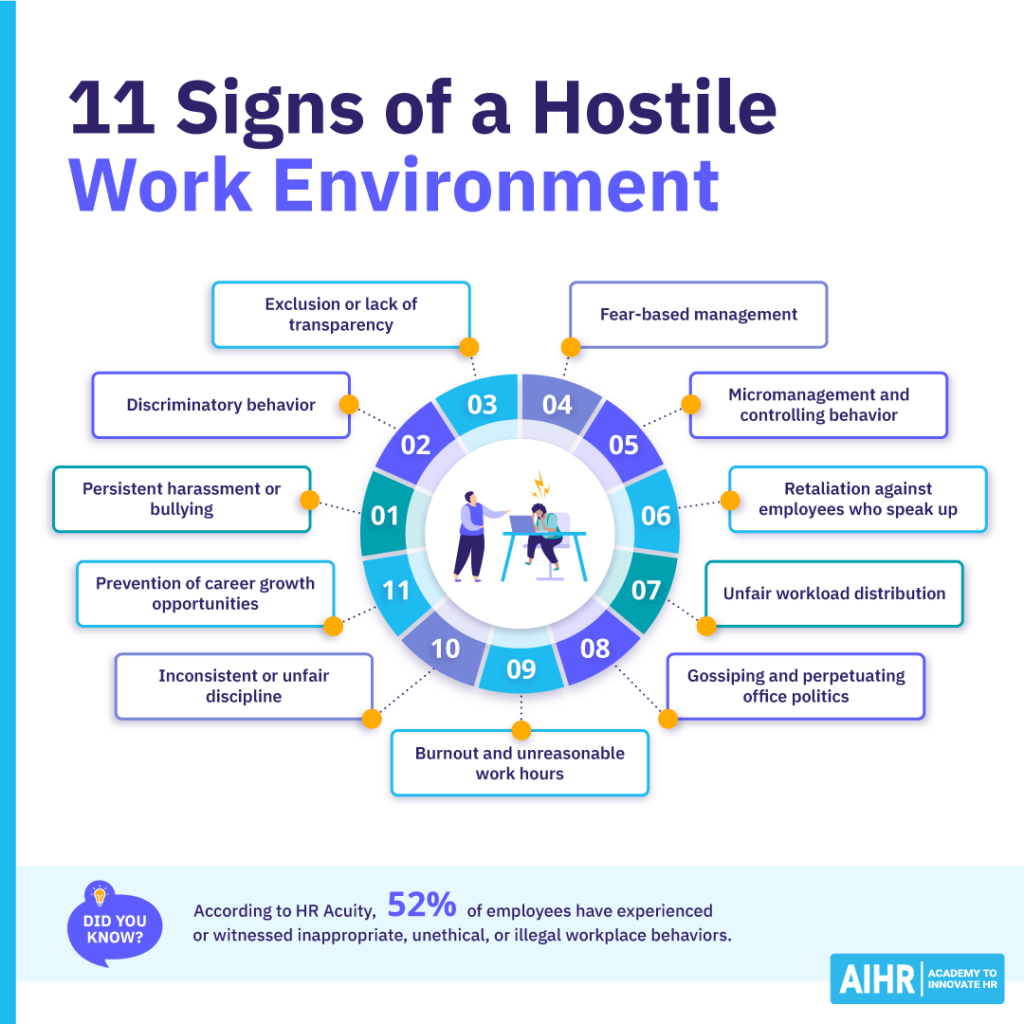
- Retaliation against employees who speak up: Punishing employees for reporting misconduct by reducing their responsibilities or isolating them from others.
→ Solution: Assure affected employees of protection, document their complaints, and investigate their allegations. Additionally, enforce strict anti-retaliation policies, and train leadership on whistleblower protection.
- Unfair workload distribution: Uneven task assignments or clear favoritism from managers or leaders toward employees.
→ Solution: Review and adjust workloads fairly, train supervisors on equitable delegation, and set realistic expectations. Also, use tools to monitor workload, and set fair performance evaluation criteria.
- Gossiping and perpetuating office politics: Malicious gossip and backstabbing that disrupt team cohesion.
→ Solution: Address conflicts directly, confront those spreading rumors, promote professional communication, and encourage team-building activities to foster a culture of transparency and mutual respect.
- Burnout and unreasonable work hours: Constant overtime and exhaustion among employees.
→ Solution: Implement realistic workloads and deadlines, offer flexible work options, enforce limits on overtime, and promote work-life balance.
- Inconsistent or unfair discipline: Uneven enforcement of rules that lead to inconsistent, biased consequences.
→ Solution: Conduct an investigation to address grievances and ensure a fair appeal process. Additionally, train supervisors for unbiased enforcement, and standardize disciplinary procedures.
- Prevention of career growth: Lack of training and promotion opportunities that leave employees feeling stuck professionally.
→ Solution: Conduct one-on-one career development meetings with employees to understand their goals and train managers to provide constructive feedback. At the same time, clarify promotion opportunities and offer skill-building programs to support growth.
23 examples of hostile work environments
Here are 23 examples of hostile work environments to help you spot the signs:
Discrimination
Workplace discrimination happens when employees receive unfair treatment based on factors like ethnicity, nationality, gender, age, sexual orientation, or disability. This can create a hostile work environment where individuals feel unsafe, disrespected, or excluded.
Example 1: Racial discrimination
An employee from a minority ethnic group repeatedly gets the least desirable tasks despite having the same qualifications as their peers. Their manager also overlooks them for promotions while less experienced colleagues advance. Additionally, their co-workers make offensive jokes about their race, creating an environment of disrespect and fear.
Example 2: Gender discrimination
A female employee receives lower pay than her male colleagues for the same role and performing the same tasks. Her superiors also consistently overlook her for promotions, indicating a lack of professional growth and development and an unequal work environment.
Example 3: Age discrimination
Leadership has pressured a senior executive to retire early because they want to hire younger workers. They frequently tease this executive about being ‘too slow with technology’ and don’t offer them tech upskilling opportunities, making them feel undervalued and alienated.
Example 4: Disability discrimination
An employee with a disability has requested an ergonomic chair so they can feel more comfortable and concentrate on their work more. However, their manager denies the request without explaining why. Coworkers also give dismissive opinions about the employee’s condition, making the employee feel uncomfortable and unwelcome.
Bullying
Bullying happens when there is mistreatment, intimidation, or exclusion of an employee repeatedly, resulting in a toxic workplace environment.
Example 5: Exclusionary behavior
A manager excludes a new employee from team meetings and team-building activities, making it difficult for them to develop rapport with the rest of the team. The new employee feels isolated and demotivated.
Example 6: Undermining work performance
A manager intentionally withholds critical resources or information from an employee. When the employee fails in their tasks as a result, they are publicly criticized instead of providing guidance. This humiliation affects the employee’s confidence and reputation.
Example 7: Spreading malicious rumors
A group of employees spread false rumors about a colleague’s personal life, creating a toxic atmosphere. The targeted employee feels anxious and humiliated, affecting their mental health and job performance.
Example 8: Public humiliation
A manager often publicly ridicules an employee and belittles their performance. This ongoing humiliation leads to stress and low morale, making the employee hesitant to join team discussions and affecting the quality of their work.
Harassment
Harassment involves repeated unwelcome conduct that creates an intimidating, hostile, or offensive work environment.
Example 9: Sexual harassment
A manager makes inappropriate comments about an employee’s appearance and repeatedly asks them out despite their explicit rejections. The employee feels unsafe and uncomfortable, impacting their ability to work.
Example 10: Persistent verbal abuse
The manager constantly shouts at, insults, and makes insulting remarks about an employee, making them feel constantly uncomfortable and stressed.
Example 11: Slurs and inappropriate jokes
An employee often receives sexist, racist, or homophobic jokes from colleagues despite having repeatedly asked them to stop. The employee has reported the incident to management, who dismisses the situation as “just office banter”. This creates an unsafe, uneasy environment for marginalized employees.
Example 12: Stalking or excessive monitoring
A manager obsessively tracks employees’ movements, constantly checks their computer activity, and micromanages their tasks. This extreme surveillance creates a suffocating and anxiety-inducing environment for the employee.
Threats
Verbal or written threats, even implied threats, create fear and instability. They make employees feel unsafe in their working relationships and overall careers.
Example 13: Threatening job security
A manager repeatedly tells employees they could be fired at any time if they don’t follow orders, which is unreasonable. This causes extreme stress and discourages employees from expressing their concerns.
Example 14: Intimidation through physical gestures
An employee aggressively slams their fist on their desk or invades colleagues’ personal space during disagreements, making others feel threatened and unsafe.
Example 15: Blackmail or coercion
A supervisor threatens to reveal personal information about an employee unless they follow the unethical requests. This manipulation creates a fearful and toxic environment.
Example 16: Retaliatory threats
Employees who raise concerns about discrimination are told that reporting the issue will “ruin their career.” This discourages employees from speaking up against workplace misconduct, perpetuating a toxic work environment.
Physical violence
Any form of physical aggression in the workplace creates an immediate hostile and unsafe environment. It can result in physical injury to targets of such behavior and place the company at risk of legal action for not maintaining a safe workplace.
Example 17: Physical assault
A disagreement between colleagues escalates into grabbing, pushing, and hitting. This violent behavior creates a fearful environment and potential legal repercussions for the employer.
Example 18: Throwing objects in anger
A manager frequently throws office supplies in frustration, narrowly missing employees. This aggressive behavior creates an intimidating work atmosphere, even if no one is injured.
Example 19: Destroying personal property
An employee damages a colleague’s belongings (e.g., deleting essential work files or vandalizing their workspace) as an act of hostility or revenge for a disagreement or perceived slight. This destruction contributes to a toxic environment and could result in legal action.
Retaliation
Retaliation happens when an employer punishes an employee for engaging in legally protected activities, such as reporting workplace misconduct or contributing to an HR investigation.
Example 20: Demoting or reassigning employees unfairly
After an employee files a complaint about workplace discrimination, their employer suddenly demotes them and cuts their pay or gives them fewer responsibilities as punishment.
Example 21: Isolating whistleblowers
An employee who reports their manager’s ethical violations is excluded from meetings and social events shortly afterward. Co-workers are instructed not to engage with them or suffer negative consequences, creating a hostile and isolating atmosphere for the entire team.
Example 22: Denying promotions or raises
An employee who raises concerns about questionable business practices is bypassed for promotions or salary increases despite their strong work performance. This retaliatory act discourages others from reporting wrongdoings.
Example 23: Unjustified negative performance reviews
A manager gives an employee an unfairly negative performance evaluation after they filed a harassment complaint against them. This damages the employee’s career progression and confidence, reinforcing a toxic work culture.
To sum up
A hostile work environment can manifest in several ways, from subtle discrimination to overt acts of violence. It’s critical for all parties, including HR, to recognize the signs of such an environment, as it creates an atmosphere of fear and destabilization in the workplace. The behaviors that make a hostile workplace can also be illegal and liable for legal action.
While it’s everyone’s responsibility to foster an inclusive work environment, HR and leadership, in particular, must watch out for any issue that hinders this and handle it promptly and fairly. They must also implement clear policies and reporting processes and prioritize open communication to make sure all employees feel safe and empowered to perform at their best.
Learn more
Related articles
Are you ready for the future of HR?
Learn modern and relevant HR skills, online







